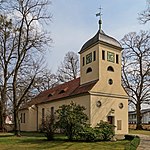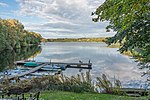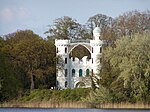Militärhistorisches Museum Flugplatz Berlin-Gatow
The Militärhistorisches Museum der Bundeswehr – Flugplatz Berlin-Gatow (Bundeswehr Museum of Military History – Berlin-Gatow Airfield; formally known as Luftwaffenmuseum der Bundeswehr), is the Berlin branch of the Bundeswehr Military History Museum. The museum acts as an independent military department. The museum is in Berlin at a former Luftwaffe and Royal Air Force (RAF) airfield, RAF Gatow. The focus is on military history, particularly the history of the post-war German Air Force. The museum has a collection of more than 200,000 items, including 155 aeroplanes, 5,000 uniforms and 30,000 books. There are also displays (including aeroplanes) on the history of the airfield when it was used by the RAF. Aircraft include World War I planes such as the Fokker E.III as reproductions, and World War II planes such as the Bf 109, as well as at least one aircraft of every type ever to serve in the air forces of East and West Germany. Most of those postwar aircraft are stored outside on the tarmac and runways, however, and many are in bad condition. There are long term restoration projects, including a Focke-Wulf Fw 190. Because of that the museum is under construction, some exhibits are shortly removed for restoration, repainting or lending to other museums.
Excerpt from the Wikipedia article Militärhistorisches Museum Flugplatz Berlin-Gatow (License: CC BY-SA 3.0, Authors).Militärhistorisches Museum Flugplatz Berlin-Gatow
August-Euler-Straße, Berlin Kladow
Geographical coordinates (GPS) Address Nearby Places Show on map
Geographical coordinates (GPS)
| Latitude | Longitude |
|---|---|
| N 52.473055555556 ° | E 13.144722222222 ° |
Address
Hangar 3
August-Euler-Straße
14089 Berlin, Kladow
Germany
Open on Google Maps









